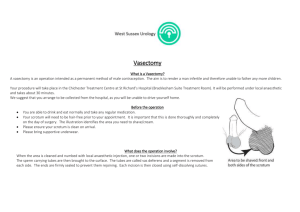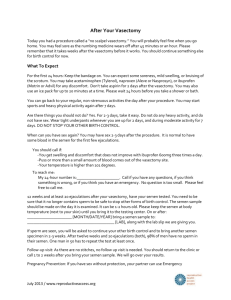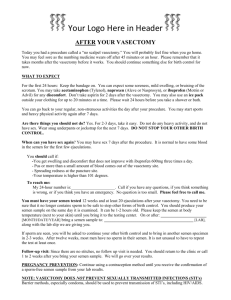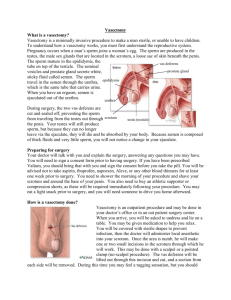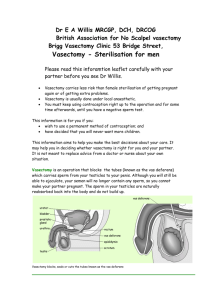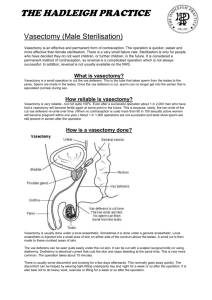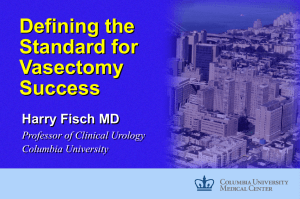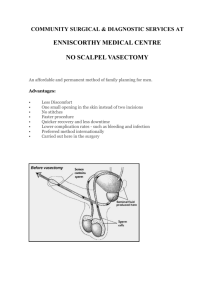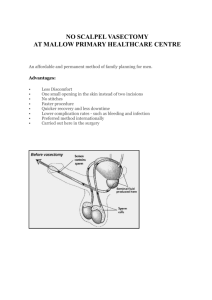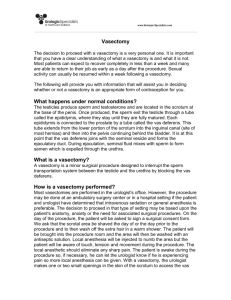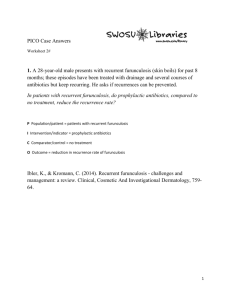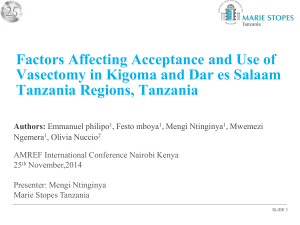Vasectomy - Loma Linda University Medical Center
advertisement
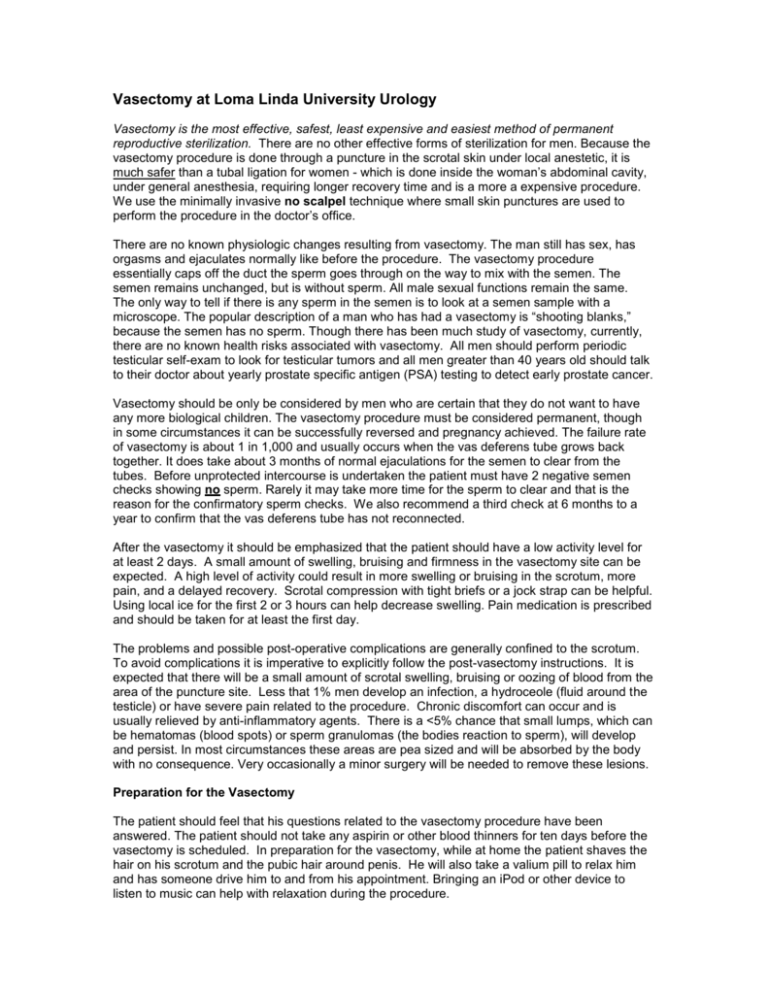
Vasectomy at Loma Linda University Urology Vasectomy is the most effective, safest, least expensive and easiest method of permanent reproductive sterilization. There are no other effective forms of sterilization for men. Because the vasectomy procedure is done through a puncture in the scrotal skin under local anestetic, it is much safer than a tubal ligation for women - which is done inside the woman’s abdominal cavity, under general anesthesia, requiring longer recovery time and is a more a expensive procedure. We use the minimally invasive no scalpel technique where small skin punctures are used to perform the procedure in the doctor’s office. There are no known physiologic changes resulting from vasectomy. The man still has sex, has orgasms and ejaculates normally like before the procedure. The vasectomy procedure essentially caps off the duct the sperm goes through on the way to mix with the semen. The semen remains unchanged, but is without sperm. All male sexual functions remain the same. The only way to tell if there is any sperm in the semen is to look at a semen sample with a microscope. The popular description of a man who has had a vasectomy is “shooting blanks,” because the semen has no sperm. Though there has been much study of vasectomy, currently, there are no known health risks associated with vasectomy. All men should perform periodic testicular self-exam to look for testicular tumors and all men greater than 40 years old should talk to their doctor about yearly prostate specific antigen (PSA) testing to detect early prostate cancer. Vasectomy should be only be considered by men who are certain that they do not want to have any more biological children. The vasectomy procedure must be considered permanent, though in some circumstances it can be successfully reversed and pregnancy achieved. The failure rate of vasectomy is about 1 in 1,000 and usually occurs when the vas deferens tube grows back together. It does take about 3 months of normal ejaculations for the semen to clear from the tubes. Before unprotected intercourse is undertaken the patient must have 2 negative semen checks showing no sperm. Rarely it may take more time for the sperm to clear and that is the reason for the confirmatory sperm checks. We also recommend a third check at 6 months to a year to confirm that the vas deferens tube has not reconnected. After the vasectomy it should be emphasized that the patient should have a low activity level for at least 2 days. A small amount of swelling, bruising and firmness in the vasectomy site can be expected. A high level of activity could result in more swelling or bruising in the scrotum, more pain, and a delayed recovery. Scrotal compression with tight briefs or a jock strap can be helpful. Using local ice for the first 2 or 3 hours can help decrease swelling. Pain medication is prescribed and should be taken for at least the first day. The problems and possible post-operative complications are generally confined to the scrotum. To avoid complications it is imperative to explicitly follow the post-vasectomy instructions. It is expected that there will be a small amount of scrotal swelling, bruising or oozing of blood from the area of the puncture site. Less that 1% men develop an infection, a hydroceole (fluid around the testicle) or have severe pain related to the procedure. Chronic discomfort can occur and is usually relieved by anti-inflammatory agents. There is a <5% chance that small lumps, which can be hematomas (blood spots) or sperm granulomas (the bodies reaction to sperm), will develop and persist. In most circumstances these areas are pea sized and will be absorbed by the body with no consequence. Very occasionally a minor surgery will be needed to remove these lesions. Preparation for the Vasectomy The patient should feel that his questions related to the vasectomy procedure have been answered. The patient should not take any aspirin or other blood thinners for ten days before the vasectomy is scheduled. In preparation for the vasectomy, while at home the patient shaves the hair on his scrotum and the pubic hair around penis. He will also take a valium pill to relax him and has someone drive him to and from his appointment. Bringing an iPod or other device to listen to music can help with relaxation during the procedure. The Vasectomy Procedure The patient is comfortably positioned laying on his back and the surgical area prepared with an antiseptic scrub to prevent infection. The doctor then grasps the vas deferens through the scrotal wall and using a small needle places a local anesthetic in the skin. (clip 1) A small puncture is then made in the scrotal skin (clip 2), the vas deferens identified and grasped with a specially shaped instrument and brought to the skin (clip3). Next a ½ inch segment of vas deferens is removed (clip 4), the ends are gently tied to stop the flow of sperm (clip 5), and tucked away from each other (clip 6). A final check is done to assure there is no significant oozing of blood from the vasectomy site and the procedure concluded (clip 7). Healing is generally rapid. After one week it would be difficult to find the area where the puncture was made. Normal activity is resumed after several days. It is very important to take it easy for a few days and be aware of cues that the body is healing. Sexual activity may be resumed after several days. Contraception should be used until two negative semen checks are done to confirm that there is no more sperm in the semen. A third check at six months to one year is recommended. Vasectomy questions Will vasectomy take away my manhood or sex life? Vasectomy does not result in any changes related to sexual desire, sexual function, ejaculation or orgasm. Any changes would be psychological. Many times when the threat of unwanted pregnancy is removed, sexual satisfaction actually increases. What are the pros of vasectomy? Vasectomy is quick, easy and effective. It almost always works (999/1000), has no long-term health risks and is cheaper and safer than female sterilization. Vasectomy removes the risks of female contraception pills. What are the cons of vasectomy? Everyone will have some small degree of swelling and bruising. There is a small chance of postprocedure complications including bleeding (<1%), bruising, swelling, infection, chronic pain, (<5%) sperm granuloma (10%) or need for further surgery (<1%). There will be a few days where strenuous and sexual activity is not advised. The apprehension prior to a vasectomy can lead to delays resulting in unintended pregnancy. What do I have to do to get ready for a vasectomy? Don’t take asprin, anti-inflammatory pain medications or blood thinners for 10 days prior to the procedure. Within 3 days of the vasectomy the patient will shave the hair on the scrotum extending to the base of the penis. This keeps the procedure field free of hair. The consent must be signed 3 days prior to the procedure. Bringing an iPod to listen to music can help with relaxation. What can I do to speed the recovery and healing from the vasectomy procedure? Healing occurs at a different rate for everyone. It is very important to have a light activity level for at least 2 days following the procedure. During this time there should be no straining (i.e. heavy lifting or exertions) as this can cause swelling. The patient should be aware of changes such as pain, swelling, redness or warmth that occur in the puncture area and should report changes to their doctor. Ice should be applied intermittently for the first 3 hours and then the patient should wear tight briefs or a jock strap. No swimming, baths or soaking in a hot tub is advised for at least one week and not until both punctures have healed. Being compliant with all of the post vasectomy instructions, as well as using common sense, will speed the healing process.
